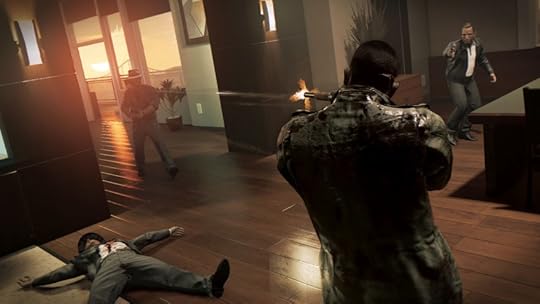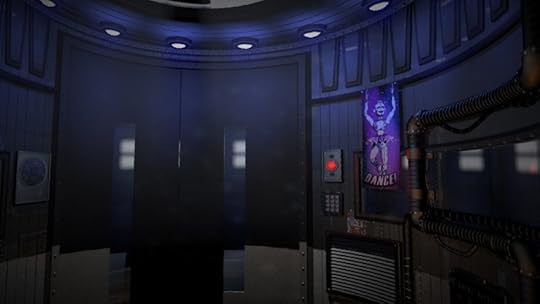Kill Screen Magazine's Blog, page 43
October 12, 2016
Surprise! Thumper is out now and it’s fast as hell
Originally scheduled to release on October 13, it appears the team at Drool decided to say, “To Hell with schedules,” and release Thumper a few days early for PlayStation VR, PlayStation 4, itch.io and Steam.
For the uninitiated, Thumper is an insane “rhythm violence” game that puts players in control of a chrome beetle, firing down its track at breakneck speeds, all the while fighting metal leviathans blocking its way. It’s bright, intense, and kind of hard to stare at, looking less like a game and more like a Hajime Sorayama painting from a neon Hell.
“can’t even describe it to someone else”
When we talked to Drool’s Brian Gibson about his game earlier this year at GDC, he told us he wants the game to be akin to a fever dream, “where you take off the gear, wake up, and can’t even describe it to someone else.” To be honest, I’ve only seen the game in trailers and I have difficulty describing it to other people, so it looks like Drool is on the right path.
As to those who have played it on the Kill Screen team, they’ve had a tough time discerning how much of a rhythm game Thumper is, being that it takes more from noise music than anything even slightly rhythmic. It’s also apparently hellbent on punishing mistakes from the get-go—feeling more like the harshest Skinner box created than PaRappa the Rapper (1996). There’s also mention of “tentacles,” “hard corners,” and several appraisals of its Robert Beatty-esque aesthetic, who, it turns out, also created the artwork for the vinyl soundtrack.
Thumper is out now. You can find out more about it on its website.
The post Surprise! Thumper is out now and it’s fast as hell appeared first on Kill Screen.
Kinky visual novel Ladykiller in a Bind is out right now
This is exciting: Ladykiller in a Bind is out now on Windows, Mac, and Linux. You’ll find the visual novel—by Analogue: A Hate Story (2012) creator Love Conquers All Games—on the Humble Bundle store. For now, Valve deemed the game too sexy for Steam, but writer Christine Love hopes to get it on there one day.
Love and her team have been working on Ladykiller in a Bind since 2012—full-time for three of those years. Its story is in stark contrast to the “brutally oppressive societal misogyny” in Analogue, of which Love has said her team was pretty burnt out on writing about. Ladykiller in a Bind celebrates consensual, kinky sex—including BDSM, if Bind didn’t already clue you in—as a student crossdressing as her twin brother during a week-long cruise.

“The lead up [to Ladykiller in a Bind’s release] was harrowing, honestly,” Love said. “Especially in the last week, there were a lot of hard decisions about how we were going to make the deadline. I think in a week I’ll be calmer about it all, but right now, it’s hard to not be terrified about how people will feel about it. I’ve only been anxiously awaiting this day for years!”
Many of the other characters are extremely kissable
Two central romantic paths are available in Ladykiller in a Bind, but many of the other characters are extremely kissable. And they’re all important in navigating the complex social structure of the game without spilling your secret. So, as the Beast, who will you choose to help you through the cruise? The Beauty or the Stalker?
Ladykiller in a Bind is Love Conquers All Games’s last visual novel before the team “move[s] onto other weird narrative genres.” And they’re tying things up (heh) in a major way; Ladykiller in a Bind is the studio’s “longest, most mechanically complex” game yet. Hottest, too, the team said.
Ladykiller in a Bind is available for $30 on the Humble Bundle store.


The post Kinky visual novel Ladykiller in a Bind is out right now appeared first on Kill Screen.
Everybody scream! It’s Overwatch on Halloween
It’s probably too early in the day for me to playing Overwatch, being around noon. After all, I have work to do. But I’m ignoring that for now. For a fleeting hour or so, I’m taking a break, because Overwatch’s latest themed event is here. And oh buddy, it’s Halloween.
A couple hours spent in Overwatch’s Halloween Terror event and I already feel as if it’s leagues better than the Summer Games from August. Maybe that’s because I’m not into sports, but skulls and pumpkins? I’m 100 percent on board. In the timely update, players can now buy the rare skins they most desire using in-game coins (just be prepared to spend a pretty penny for it). The best skins and sprays of the bunch obliterate the sportiness of the last event’s Olympics-themed wear. The Hollywood map is now adorned with spooky décor and overcast skies, making it more ghastly than before. And best of all: no Lucioball in sight! Instead, there’s a brawl that’s actually fun to play! And it’s a horde mode with difficulty levels.
skulls and pumpkins? I’m 100 percent on board
Overwatch’s latest brawl, “Junkenstein’s Revenge,” is, as I stated above, a horde mode for four co-operative players, the only available heroes being Ana, Hanzo, McCree, and everyone’s daddy, Soldier: 76. Together, the four well-versed acquaintances defend the castle in the Eichenwalde map against an onslaught of robotic Zomnics, Pumpkin King Reaper, Dr. Junkenstein, Junkenstein’s Sad (keeping with Mary Shelley’s classic novel) Monster (also known as Roadhog), and the Witch (or, Mercy). There’s even a new digital comic to celebrate the occasion.
But I guess not all players will find themselves enamored with yet another horde mode, since Gears of War 4 did just come out to scratch that horde-slaughtering itch. Alas, we all know the best part of any themed event: the skins. To reign in the momentous occasion, here’s the best eerie outfits for our favorite heroes (even if I’m still sour on the omission of a giant jack-o-lantern piloted by D.Va).
12. Soldier: 76 looks like he forgot about his invite to a Halloween party, but luckily had some ghostly make-up and a very Thriller-esque jacket lying around to make up for it.
11. Well, at least Symmetra’s tights are kinda spooky.
10. Okay, Hanzo’s demonic skin isn’t that great either. But he’s one of my mains, so if I get it I’m bound to equip it.
9. Iridescent Zombie Pharah looks nice, finally an excuse for me to unequip those godawful Native American skins.
8. I don’t usually like any of Ana’s skins that cover her face—I want to embrace the grandma—but at least she has this adorable candy giving emote. I’d like some sour gummy worms please, scary grandma.
7. Reinhardt officially has too many good skins.
6. R.I.P. to all those who cross the deadly Bastion’s path. Pour one out for all the heroes with no festive skins.
5. I never knew I wanted Skelly Zeny until this very moment. God bless. Discord orb me, bone daddy.
4. & 3. Roadhog and Junkrat are a match made in heaven. A “ship” as netizens may say. Or an “OTP.” And with these equally grotesque skins, they remain.
2. If it lives, Pumpkin Reaper can kill it.
1. Here it is, the winner of this ranking. The crème de la crème. The witch who will Guardian Angel-glide straight into my heart, before whipping out a pistol to destroy any enemies in our wake. I love her. I’m sure you do too.
Overwatch’s Halloween Terror event is available now . Everybody scream! It’s Overwatch on Halloween.
P.S. Nearly everyone’s new individual spray is a cute kid-version of themselves in shoddy versions of their costumes, except for our favorite disgruntled dad:
The post Everybody scream! It’s Overwatch on Halloween appeared first on Kill Screen.
Farewell, Civilization V
The Civilization series of games moves in cycles. On October 30, 2001, Civilization III was released; October 25, 2005 brought Civilization IV; the latest incarnation of the series was released September 21, 2010; and now Civilization VI arrives on October 21. There is a wistful sense of loss in this pattern—after a spring and summer five years long, the massive canopy of the previous Civilization game fades away to make room for the next, bigger, and hopefully better incarnation.
But this is the wrong metaphor. The Civilization series is concerned with civilization: with cities, with growth, with increasing cultural and material complexity over time. Each game suddenly appears on top of the previous one, like one of their in-game Wonders. It’s a series that repeatedly builds upon itself, its past evinced in the strata beneath the current layer. Gandhi’s traditional propensity for nuclear wars is the best example of this sense of tradition. The joke goes something like this: In the original Civilization, a value between one and 10 was assigned to each AI’s belligerence. Gandhi was given the lowest possible value—a one. This introduced a problem later on in the game, when a technology was unlocked that lowered every AI’s belligerence score by a few points. Rather than reducing Gandhi’s to zero, the code rolled back to the highest possible value: 255. So, at a predictable point in the game, Gandhi would transform from peaceful partner to a frothing, belligerent maniac who was dozens of times more violent than any other AI. What started out as a bug became a feature: every instance of the character, in any Civilization game, will go literally ballistic when they’ve unlocked nuclear weapons.
The list of additive innovations goes on. Civilization IV introduced quotes associated with each technology (narrated, originally, by Leonard Nemoy), which carried on into later games. Recurrent civilizations with recurrent leaders are other artefacts whose presence can be traced through the various layers—Shaka Zulu, Mongolia under Genghis Khan, and, of course, India under Gandhi. Perpetually present also is the Western parochialism that defines, for the series, what the word ‘Civilization’ means—but this article is meant as an eulogy, so we’ll pass over that in forgiving silence. But Civilization V is that layer of ash beneath London that speaks of when Boudicca burned the city, or that is Troy VII and speaks to its mythic destruction at the hands of the Achaeans. Civilization V is when the record changed decisively: gone were the square tiles, replaced with a mesh of hexagons; where once whole armies occupied a single square, now only a single military unit could occupy a single tile. Cities became defendable objects that didn’t need a garrisoned unit to prevent enemies from waltzing in.
But these details—the units and chessboard layout—are an innovation of what was already present. Civilization V also brought with it espionage (with appropriately named spies), as well as religious and tourism mechanics that have entered the latest iteration as base gameplay after various haphazard experiments in previous games. City States were a new and tokenistic addition too, where cities whose home did not merit inclusion in the base game could now be found: Zurich, M’Banza-Kongo, and Kuala Lampur, all reductively classified as either maritime, military, commercial, or religious. Historical art objects became an important part of the game, while certain civilizations have the ability to create unique tile improvements. We have archaeologists and the introduction of historical artefacts. Civilization VI will let you play as a fascist England or a communist America once the player hits the modern era, but that system began with Civilization V.
Civilization V is that layer of ash beneath London
However, these mechanics are the canvas the game uses for its colors. The real draw of the game has always been the various civilizations available. And how many civilizations are there in Civilization V? Provided you have both expansion packs (Brave New World and Gods and Kings), 43 civilizations, from America to Zulu, are available. This includes nations as diverse as the Iroquois, the English, and the Ottomans. And, as is custom, there are civilizations that appeared for the first time in Civilization V: Poland, Assyria, the Songhai, Venice, the Shoshone, and others.
But the base 43 are merely the beginning. Civilization V came when the mod community began to come into its own, and these mods allow for the additions of, after five years, hundreds of unofficial civilizations. Of special note is the Colonialist Legacies series, which seeks to present a variety of nations and peoples created, affected by, and eliminated by the history of European Colonialism. First Nations are represented through a diverse group comprised of the Anishinaabe, Cree, Inuit, Blackfoot, Dene, Tlingit, and Wabanaki. Beyond North America, you have the Afghans led by Mirwais Hotek, Vietnam led by the Trung Sisters, Malaysia as led by Parameswara, and others. Two distinct Australian aboriginal civilizations are present: the Kimberley and the Kulin. And, of course, there is Canada, led by Lester B. Pearson.
These are merely the best, most professional examples of these community-made mods, complete with balanced abilities, appropriate in-game music, and even voice acting in the appropriate language—the Australia mod even has an animated screen for its leader, instead of, like most mods, a static image. But beyond quality, there is the fact of those unfamiliar names: how often do the names Mirwais Hotek or the Trung Sisters appear in day-to-day life? The mods, in essence, take their cue from the base game: both are constantly seeking to find some relatively unknown corner of the world and bring it to light, to show it to players and say, admiringly, “isn’t this incredible?”
In many ways, the mods go deep when the base game has to satisfy itself with going wide: Firaxis’ Civilization must lump all of Arabia or the Celts into one monolithic civilization, while the mods can parse this blanket approach apart—the Ayyubids and the Timurids or the Iceni and the Picts. But they are both animated by the same interest in taking something of that nation, that people, that empire, or that state and introducing players to their particularities. Earlier games sought to differentiate the various Civilization games by providing a different combination of starting technologies (Civilization III) or a unique unit and building (Civilization IV). But Civilization V made every civilization functionally unique by providing a different ability that reflected that culture’s distinctiveness: in the base game, the Huns burn cities twice as quickly and have an emphasis on horse archers that reflects their historical devastation of Rome. The fan community followed the developer’s lead by creating, for example, the modded Inuit civilization, who allow for the use of normally-useless tundra and snow tiles for growth, reflecting their native environment. These details are reductive, of course, implying that the uniqueness of a given culture or country can be boiled down to a unique building and a twist of the number value of certain bonuses. Yet even as the Civilization series goes on, we may see this emphasis on distinction and particularity grow—but the way in which the very nature of the gameplay reflects the specific character of your chosen civilization began with Civilization V.
So when we say goodbye to this game, we wish a fond farewell to a quizzical AI asking whether the army massing at their border is intended as an invading force. To the novelty of actual chessboard tactics, as positioning and movement order mattered in a way they never had before. But we are not just saying goodbye to this liminal game that represented a shift in the series. We are saying goodbye to the specific histories and characters, the moment when the game’s appreciation of its subject matter became more affectionately familiar. The base Civilization will always have an African empire, but it won’t always have the Songhai as led by Askia, who fears no hostile river crossing and whose mandekalu cavalry are better than most horsemen at attacking cities.
It is to the series what the Norman Conquest was to the English language
In essence, we are saying goodbye to the moment when Civilization became something that resembles other artefacts present in a civilization: language, visual art, style, fashion, whatever. Civilization I to IV were variations on a theme: the same chessboard layout, with a few changes (II and III, memorably, had a global warming mechanic) and graphical updates. Civilization V has connections to its past, but it innovates on those connections. It is to the series what the Norman Conquest was to the English language, or the invention of the stirrup to cavalry. The gap between Civilization IV and V is greater than that between V and VI—that monument to innovation deserves recognition.
Of course, the above is, partly, dramatic nostalgia. Civilization V is not actually going anywhere—it won’t disappear from anyone’s Steam account. It’s just being buried beneath the next layer. But, as with the catacombs of Paris or Rome, that underground layer speaks of a past that was once living, once its own utterly alive, breathing moment—but now serves only as a marker on the long road to the present. These catacombs may be visited by a few plucky archaeologists, but Civilization VI is now the present; Civilization V has been transformed into what came before.
The post Farewell, Civilization V appeared first on Kill Screen.
October 11, 2016
The Festival Floppies is a treasure trove of forgotten videogame history
Archivist Jason Scott is attempting to preserve the inherent historical value of videogames. The Festival Floppies is part of this project. Years back, Scott acquired a load of floppy disks that a friend found in 2009 at the Timonium Hamboree and Computer Festival in Baltimore, Maryland. Back then, the disks were just a collection of software in a big plastic box. But now they’re The Festival Floppies.
Scott unloaded each of these disks, unearthing the software using a USB floppy drive and a program designed to pull stuff off the disks. All of the imaged files are available on the Internet Archive for folks to download and mess with. But if that’s not your thing, don’t worry—you can actually run more than 500 of these programs straight from your browser. It’s a valuable resource.

There’s a huge variety of programs in The Festival Floppies—a map of the United States that names each state and its capital; a Krusty the Clown screensaver; an early John Romero game; and a text file with jokes about lawyers. SimCity, which was released in 1989, is also in there somewhere. No real link exists between these programs, save that they were “sitting in a box on a vendor table in Baltimore in 2009.”
“There’s a sliver of interest in what could be called ‘old games’ or ‘retrogaming’ or ‘remixes/reissues’ and so on,” Scott said. “It’s pretty much only games, it’s pretty much roughly 100 titles, and it’s stuff that has seeped enough into pop culture or whose parent companies still make enough bank that a profit motive serves to ensure the ‘IP’ will continue to thrive, in some way.”
Many of The Festival Floppies programs have long been forgotten
But what about everything else? “There’s entire other experiences related to software that are both available, and perhaps even of interest to someone who never saw this stuff the first time around,” he added. That’s why The Festival Floppies matter, and why Scott took the time and effort to dust off these floppy disks and put ’em on the internet.
Some big Canon Influencer in the world has decided which of these programs deserve to be preserved and interacted with, stifling the history of human creation that is these sorts of floppy disks, and the programs on them. Many of The Festival Floppies programs have long been forgotten, but now they’re available again—for free—to be played with over and over again. Long live forgotten videogame history.
The Festival Floppies collection is available online.


The post The Festival Floppies is a treasure trove of forgotten videogame history appeared first on Kill Screen.
Beholder will turn you into the eyes and ears of a dystopian state
Most dystopian media places you in the shoes and mindset of the individual realizing the horrors of their world, from 1984‘s (1949) Winston to The Hunger Games‘s Katniss. Even in the videogames that feature protagonists working for the governmental power such as Papers Please (2013), the tone is one of rebellion and struggle against the society’s hardships. You may have to invade privacy and abide by Arstotzka’s rules in Papers, Please, but your suffering family and the consequences of disobeying are always guiding your actions.
Beholder takes the opposite approach. You’re not the victim, but rather the eyes and ears of a totalitarian state. You’re the shady tenement manager that typical protagonists would be careful to avoid while planning a revolt, the one that would make a surreptitious call to the authorities after seeing the heroes sneak out after curfew.
As landlord, it’s your job to keep a watchful eye over the residents of your building. Peering through keyholes, searching apartments for contraband, and playing hidden cameras in the rooms of suspicious tenants are all within your purview. Find evidence that someone is acting against the state, and your report to the authorities will lead to them being beaten and dragged off to some unseen prison. All in a day’s work for a loyal citizen.
Why report someone when blackmailing them is so much more profitable?
Of course, holding such power over your residents can encourage more aggressive and selfish behavior. Why report someone when blackmailing them is so much more profitable? Within your building, many characters and stories unfold, and your decisions—report, blackmail, or even help—can determine their outcomes and Beholder‘s ending. Maintaining your humanity in this dark dystopian world may be more important than being yet another cog in the government’s oppressive machine.
Beholder is coming to Windows and Mac this fall, and currently has a demo available on its Steam page. More details on Beholder and Warm Lamp Games can be found on Twitter and Facebook.
The post Beholder will turn you into the eyes and ears of a dystopian state appeared first on Kill Screen.
Mafia III is a big “f*ck you” to its predecessors
There’s an attractive quality to the crime stories of the first two Mafia games. Two protagonists down on their luck—Tommy Angelo in the first and Vito Scaletta in the second—find success through a life of crime, wanting nothing more than to rise through the ranks, to be wealthy, to be a “Made Man.” Mafia III doesn’t care for that.
Were it a different Mafia game, you may look at Mafia III’s Sal Marcano as a father figure, assisting your transition to the Italian mafia. Sal’s son, Georgi Marcano, might be your best friend, your confidant. In a different Mafia game, you’d be expected to forgive the sins of the Marcanos, because you knew them not first as criminals, but as people.
In a different Mafia game, you would learn who the men behind the guns were, you would be asked to empathize with their bloodshed as it benefited the family—after all, family is everything. The violence would be attractive, because one day, you may sit at the head of the table, drinking fine scotch, smoking illegal cigars, and giving orders that will one day turn your family into the city’s most powerful mob. It’d be attractive, flashy, and the antithesis of what Mafia III actually is.

Where the first two games glorify violence and crime, their newest brother objectifies it. It trades in the rose tint of their bloodstains for grit, grime, and horror. Mafia III’s protagonist, Lincoln Clay, has only one objective: to gut the very type of crime syndicate you spent two previous games trying to run. To burn everything the Marcanos hold dear to the ground after they betrayed Clay by killing members of his family and the black mafia.
Six years after the last Mafia game, Mafia III feels like the step the series is supposed to take. It would be tiresome to tell yet another story of a young man trying to pay his dues to a new family. And so it’s fitting that Mafia III takes place in 1968, as it almost feels like it’s rebelling against its predecessors, as if developer Hangar 13—which was built to take on the series—rejected the status quo set forth by the series’s creator 2K Czech (formerly Illusion Softworks).
You didn’t have to be that brutal
Lincoln Clay is a man controlled by anger, blinded by revenge. Sure, he too is taking control of city districts and collecting the wealth that comes, but he pours all of his earnings into his objective. He doesn’t buy cars, he buys bullets; he doesn’t dream of mansions, he dreams of murder; and he doesn’t kill professionally, he kills by necessity. The murders he commits each have a tangible weight to them, as each life taken is another step towards exacting the revenge he obsesses over. Mafia III’s violence matches that tone. It’s gruesome, horrific, and hard to look at. But, more than that, it’s personal, intimate.
The game often asks you, the player, to parallel Clay’s headfirst dive towards revenge. You press the button that stabs a man repeatedly in the face; you make the choice to hold the “O” button down long enough to make Clay dig his barrel down into the throat of a man’s mouth as he looks back in abject terror, before shooting him through the back of the head. You didn’t have to be that brutal, you could have quickly pressed “O” and foregone the brutal execution entirely by quickly knocking the guy out or breaking his neck. But you’re along for the ride—sometimes you’re just as mad as Clay, you share his hatred, and you may surprise yourself at how often you want your murders to be as horrific as possible. As if you yourself are dealing back the pain inflicted physically and mentally to your virtual character.

In a different Mafia game, you might shoot from afar. A murder might be celebrated with a promotion. You might take out a target and be rewarded with a cut scene of your character buying a fancy new car, or a montage that shows him slowing down his a life of crime to get married, to have a daughter.
But in Mafia III, a murder is only met with more anger. Nothing ever gets better. Hell, Clay—in a very not subtle metaphor—lives in a house that was set on fire the night Marcano betrayed his family, its walls blackened and its interior falling apart, it reflects the inner workings of his mind. Clay’s target may be to prevent that aforementioned mafioso from settling down. Why should he care about his family when no one cared about his own?
In Mafia III, you tear apart everything you hoped for in Mafia (2002) and its 2010 sequel. In that respect, it sets itself apart from its predecessors as an intentional “fuck you” to the life of crime you might have daydreamed about while playing the first two games. Mafia III forces you to light the match that will burn down everything you wanted as a corrupt, rich white man.
The post Mafia III is a big “f*ck you” to its predecessors appeared first on Kill Screen.
Five Nights At Freddy’s: Sister Location is a glorious return to cheap, nasty horror
One can only sympathize with Scott Cawthon. Once a struggling game-maker, he seems concerned that, just as unexpectedly as it arrived, his recent success might disappear. So he’s been working it while it’s hot—inside two years, he’s put out six different Five Nights at Freddy’s games.
But 2, 3, and 4 were all poor. To keep his audience hooked, Cawthon introduced side characters, back stories, and vague, irrelevant mysteries. He created a lore. FNAF became turgid. And its original, wonderful premise and mechanics were drowned by arbitrary plot twists. The newly released Sister Location marks yet another chapter in the Freddy’s canon, and at its weakest, when it makes passing references to events from the other games, it resembles a spin-off. Moment to moment, however—if you can ignore the overarching story, and Cawthon’s nervous attempts to create a bilious, Marvel-like “multiverse”—it’s as funny, frightening, and odd as the very first game.
Sister Location finds horror in the smallest of things
Elements from the rest of the FNAF series are present, but Sister Location possesses comparative brevity and a lightness of touch. Where the third and fourth entries in particular relied on contrived, long-winded narrative setups, Sister Location finds horror in the smallest of things. In its most frightening scene, you are trapped inside a cupboard and must fight to hold the door shut while an animatronic pries it open from the other side.
Sister Location is comprised of several of these short vignettes—as opposed to the other FNAF games, which you survived by learning enemies’ behavior patterns, rarely in Sister Location will you do the same thing twice. One distinct sequence, wherein you must disassemble an animatronic by locating its tiny, hidden reset buttons, gives way to another, as you crawl through a pitch-black room, trying not to disturb a horrifying, childishly-voiced robot called Ballora.
Cawthon’s eye for macabre, unsettling images—especially among independent and solo game-makers—is unchallenged. Between shifts, your character relaxes at home and watches TV. It’s such a tiny detail, but placing a photographic image of popcorn among Sister Location‘s otherwise colorful, abstract environment makes the game look so hokey and cheap, and cheap horror—The Texas Chain Saw Massacre (1974), The Blair Witch Project (1999)—is nastier, often better horror. Cawthon is presumably well financed by now. But there’s a difference between selling out and selling. His games still look like, and are, the product of one very wild imagination.
Although, credit must also be given to Heather Masters, the voice actor behind Sister Location‘s undeniably sympathetic antagonist Circus Baby. Where FNAF previously tried to emphasize its monsters by giving them increasingly gruesome visages and histories, in Sister Location, a simple voice, a few softly spoken words—“I thought you liked me, I thought I did everything right”— make Circus Baby the series’s most frightening and tragic character. Masters’ siren coos are as eerie as they are impossible to resist.
And what an ending. Funny, frightening, and visually powerful, it exceeds even the grim sarcasm of the original Five Nights, which after a week of horror and torture, awarded you a measly $120 pay stub. Sister Location, financially, is a safe bet for Cawthon—given how anxiously he responds to even the tiniest perceived failure, the certainty of return on an established series must provide him some comfort. But creatively, it’s his freshest endeavor in over two years. Between slapstick humor to physical and psychological horror, even character drama, Sister Location gracefully, gleefully, rapidly moves.
You can purchase Five Nights At Freddy’s: Sister Location on Steam.
The post Five Nights At Freddy’s: Sister Location is a glorious return to cheap, nasty horror appeared first on Kill Screen.
Composer makes Metroid even more eerie with new synth soundtrack
In 1986, Metroid was released for the Nintendo Entertainment System. Since then, Hirokazu Tanaka, Metroid’s composer, has been revered for helping create the game’s iconic, eerie atmosphere. To up Metroid’s creeping feeling of loneliness some 30 years later, composer Luminist is rerecording the game’s music using actual synthesizers.
“My initial interest behind doing this was thinking that if the technology were available back then to put hi-fi recordings into a videogame, they might have done it this way with Metroid,” Luminist said. “I’m just interested in bringing out more of the inherent alone-in-space factor that the original gave us with bleeps and bloops.”
So far, Luminist has uploaded five analog synth remakes from the Metroid soundtrack. He’s not messing with the original compositions at all, though, simply rerecording Tanaka’s original tunes to give it an “80s film score vibe.” And the rest of the soundtrack is on its way too; Luminist is aiming to release one track a week on YouTube until he’s finished the whole thing.
The latest track, Metroid’s “Item Room,” was released Sunday night. (Hear it below.)
After that, he’ll consider releasing the full album for download, should be get the licensing in order, of course. And then, after that, maybe Luminist will turn to writing his own music for videogames. “After gaining a bit more of a following,” he said, “I’ll release some of my original music and see what happens from there.”
Find Luminist’s music on YouTube.
The post Composer makes Metroid even more eerie with new synth soundtrack appeared first on Kill Screen.
Shenzhen I/O, a game that lets you be a fake engineer
Those who’ve devoted their lives to the Cartasian Discipline in Neal Stephenson’s Anathem (2008) are subject to rote memorization when they’ve broken the rules of their society. The book in which they’re to memorize from is filled with illogical nonsense, like nursery rhymes that don’t quite rhyme—a particularly aggravating punishment for a group of people dedicated, simply, to the pursuit of knowledge.
“The way they punish them is by making them learn stuff that literally means nothing and is just making their lives harder,” Shenzhen I/O creator Zach Barth said. “I think of [Shenzhen I/O] in that way.” But, like, in a good way.
“We’re inventing these fictional systems that you can become an expert in”
Shenzhen I/O is an engineering simulator of sorts; the player is a new employee of a Chinese electronics company—Shenzhen Longteng Electronics Co., Ltd.—located in the electronics capital of the world, Shenzhen. The company creates all sorts of stuff, from an electric sandwich maker marketed toward sandwich-loving Americans, to complex solutions for self-driving cars. Players just use a fake assembly language and make-believe circuits to do it. “We’re inventing these fictional systems that you can become an expert in, but none of it is transferable,” Barth said. “That’s the beauty of it.”
Barth and his team—which includes narrative designer Matthew Seiji Burns—went deep into creating this fictional world of consumer electronics, which is set in our world, just 10 years in the future. Much of what players create in-game drives Shenzhen I/O’s narrative forward. “The products that you build talk about the world that players live in,” Burns said. “One of the products is a pollution sensing window that automatically closes the window when the pollution is too high.”
The game comes with a manual, too; it’s more than just a tool to progress in the game, though. It’s part of the story, and supposed to mimic much of what it’s like to be an engineer. Filled with information from different sources, some of it “strategic bullshit,” Barth said, the manual is essential in playing Shenzhen I/O. Not only with what’s in there, but what’s not, too—again, just like if you actually were an engineer.
“You have this manual which tells you maybe 80 percent of what you know,” Burns said. “There’s another 20 percent that’s just not documented.” That’s when you turn to your engineering community. And sometimes, it’s just not documented anywhere. Or least, not in a certain language. “And that’s another layer of storytelling we can play with.”
Shenzhen I/O is available on Steam Early Access. Check out other Zachtronics games like TIS-100 and Infinifactory on the Zachtronics website.
The post Shenzhen I/O, a game that lets you be a fake engineer appeared first on Kill Screen.
Kill Screen Magazine's Blog
- Kill Screen Magazine's profile
- 4 followers

























